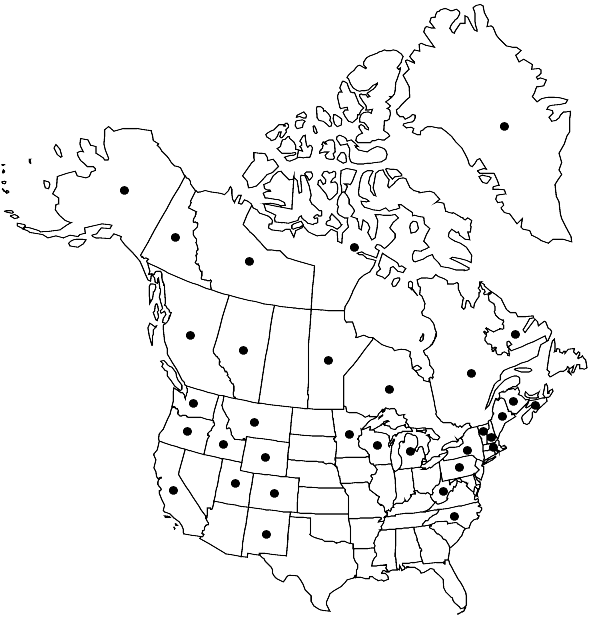Polytrichastrum alpinum
Mem. New York Bot. Gard. 21(3): 37. 1971,.
Plants very variable in size, small to robust, dull green or brownish green, reddish with age, in loose or compact tufts. Stems (1–) 4–6 (–14) cm, densely leafy above, often leafless and threadlike below, simple or sparingly to fasciculately branched. Leaves (4–) 5–8 (–19) mm, loosely to densely imbricate, erect-spreading and subtubulose when dry, erect-spreading to widely spreading when moist; sheath ± nitid, elliptic to obovate, with tapering shoulders (in var. fragile contracted above the sheath and the blade caducous), broadly hyaline-margined; blade linear-lanceolate, the apex narrowly acute to finely acuminate; marginal lamina 2–5 cells wide, erect, coarsely serrate with multicellular teeth, distantly serrulate to subentire; costa excurrent, ending in a short, brownish, toothed awn; lamellae 5–8 cells high, entire in profile, the marginal cells with the free wall appearing greatly thickened, the marginal cells in section enlarged, yellowish to dark-brown, ovate to narrowly ovate, the lateral walls strongly thickened, the lumen narrowly pentagonal and pointed at the apex, coarsely papillose; median cells of sheath 40–60 (–80) × 6–12 µm, elongate-rectangular, thin-walled; cells of the marginal lamina 10–15 µm, subquadrate, sometimes transversely elongate; perichaetial leaves scarcely longer than the stem-leaves. Seta (1–) 3–5 cm, brownish. Capsule various, (1.5–) 3–5 (–8) mm, terete, narrowly cylindric to oblong-cylindric and curved, ovate-cylindric, or ovoid to almost spherical, suberect to inclined to almost horizontal; hypophysis tapering, rugose, with numerous conspicuous stomata in a broad basal band; exothecial cells irregularly rectangular, not bulging or mammillose, thin spots absent, rather thick-walled; peristome 600 µm (teeth 150–250 µm), divided to 0.6–0.75, the teeth 45–50, with some teeth irregularly developed and unequal, pale to somewhat darker in the median line. Spores 14–20 µm.
Distribution

Widely distributed in northern North America, and throughout cool temperate and boreal latitudes in the Northern Hemisphere, s temperate South America, Pacific Islands (New Zealand), Australia, Antarctica
Discussion
Varieties 8 (4 in the flora).
Polytrichastrum alpinum is highly variable in habit and plant size, dentition of the leaves, and capsule shape. However, all forms of the species are easily recognized by the entire-margined, coarsely papillose lamellae and terete capsules with smooth, non-pitted exothecial cells. The marginal cells of the lamellae in section are distinctive in shape and wall thickening, elegantly described by A. J. E. Smith (2004) as “strawberry-shaped.” The wall thickenings extend down the lateral walls, so that in profile the free margin appears to be much thicker-walled and the lumen more restricted than is actually the case. The marginal cells of P. sexangulare are similar in shape and wall thickening, but smooth. The only North American taxa of Polytrichaceae likely to be confused with P. alpinum when sterile are Meiotrichum lyallii and Pogonatum urnigerum. In P. urnigerum the marginal cells of the lamellae are shorter and broader at the apex with a pentagonal lumen; in M. lyallii the marginal cells seen in profile are irregularly striate and pitted rather than papillose.
Selected References
None.
Lower Taxa
Key
| 1 | Plants medium to robust; leaves sharply serrate; capsules short- to long-cylindric | > 2 |
| 1 | Plants small (1-2 cm); leaves entire to finely and remotely serrate toward the tip; capsules ovoid to subglobose | > 3 |
| 2 | Plants medium, (2-)4-6(-10) cm; leaves (4-)5-8 mm; capsule 3-5 × 0.8-1 mm, short-cylindric or slender and subarcuate. | Polytrichastrum alpinum var. alpinum |
| 2 | Plants robust, to 14 cm; leaves 12-14(-19) mm; capsule 5-8 × 1.5-2.2 mm, often ± zygomorphic and widest below the middle. | Polytrichastrum alpinum var. sylvaticum |
| 3 | Leaves not fragile, not constricted at junction of sheath and blade, the blade persistent | Polytrichastrum alpinum var. septentrionale |
| 3 | Leaves fragile, constricted at the junction of sheath and blade, the blade caducous | Polytrichastrum alpinum var. fragile |
"broadened" is not a number."wide" is not a number.